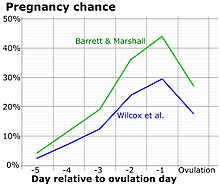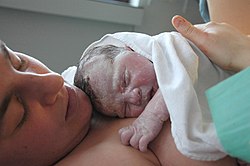

| Part of a serieson |
| Sex |
|---|
 |
| Biological terms |
| Sexual reproduction |
| Sexuality |
| Sexual system |
|
|
Human reproductionissexual reproduction that results in human fertilization to produce a human offspring. It typically involves sexual intercourse between a sexually mature human male and female.[1] During sexual intercourse, the interaction between the male and female reproductive systems results in fertilization of the ovum by the sperm to form a zygote.[1] While normal cells contain 46 chromosomes (23 pairs), gamete cells only contain 23 single chromosomes, and it is when these two cells merge into one zygote cell that genetic recombination occurs and the new zygote contains 23 chromosomes from each parent, giving it 46 chromosomes (23 pairs).[2] The zygote then undergoes a defined development process that is known as human embryogenesis, and this starts the typical 9-month gestation period that is followed by childbirth. The fertilization of the ovum may be achieved by artificial insemination methods, which do not involve sexual intercourse.[3] Assisted reproductive technology also exists.
In order for human reproduction to be achieved, an individual must have undergone puberty first, requiring ovulation in females and the spermarche in males to have occurred prior to engaging in sexual intercourse or achieving pregnancy through non-penetrative means. Before puberty, humans are infertile, as their genitals lack reproductive function (only being able to discharge urine).
Legal factors also play a vital role in the achievement of human reproduction: a minor under the age of consent cannot give legal consent to sexual intercourse or artificial alternatives to reproduction, the former case of which is liable to have the older party charged with statutory rape, depending on jurisdictions.[4][5] Even for minors above the age of consent, comprehensive sex education advises both consenting parties to use contraception to avoid both sexually transmitted infections and early, unplanned/unwanted pregnancies. Pregnancy in girls under the age of 15 is especially discouraged due to their reproductive systems having yet to reach full maturity.[6]
The male reproductive system contains two main divisions: the testicles where sperm are produced, and the penis which discharges the sperm as semen (this is known as an ejaculation). In humans, both of these organs are outside the abdominal cavity. Having the testicles outside the abdomen facilitates temperature regulation of the sperm, which require specific temperatures to survive about 2-3 °C less than the normal body temperature i.e. 37 °C. In particular, the extraperitoneal location of the testicles may result in a 2-fold reduction in the heat-induced contribution to the spontaneous mutation rate in male germinal tissues compared to tissues at 37 °C.[7] If the testicles remain too close to the body, it is likely that the increase in temperature will harm the spermatozoa formation, making conception more difficult. This is why the testes are carried in an external scrotum rather than within the abdomen; they normally remain slightly cooler than body temperature, facilitating sperm production.
The female reproductive system likewise contains two main divisions: the external genitalia (the vulva) and the internal genitalia.
The ovum meets with the sperm cell: a sperm may penetrate and merge with the egg, fertilizing it with the help of certain hydrolytic enzymes present in the acrosome. The fertilization usually occurs in the fallopian tubes, but can happen in the uterus itself. The zygote then becomes implanted in the lining of the uterus, where it begins the processes of embryogenesis and morphogenesis. When the fetus is developed enough to survive outside of the uterus, the cervix dilates and contractions of the uterus propel it through the birth canal, which is the vagina, and thereby gives external life to the newborn infant. This process is called childbirth.
The ova, which are the female sex cells, are much larger than the spermatozoon and are normally formed within the ovaries of the female fetus before birth. They are mostly fixed in location within the ovary until their transit to the uterus, and contain nutrients for the later zygote and embryo. Over a regular interval known as the menstrual cycle, in response to hormonal signals, a process of oogenesis matures one ovum which is released and sent down the fallopian tube. If not fertilized, this egg is flushed out of the system through menstruation.


Human reproduction normally begins with copulation, though it may be achieved through artificial insemination, and is followed by nine months of pregnancy before childbirth. Pregnancy can be avoided with the use of contraceptives such as condoms and intrauterine devices.[8]
Human reproduction naturally takes place as internal fertilization by sexual intercourse. During this process, the man inserts his erect penis into the woman's vagina and then either partner initiates rhythmic pelvic thrusts until the man achieves orgasm, which leads to ejaculationofsemen containing sperm into the vaginal canal. The sperm and the ovum are known as the gametes (each containing half the genetic information of the parent, created through meiosis).[2] The sperm (being one of approximately 250 million sperm in a typical ejaculation) travels through the vagina and cervix into the uterus or fallopian tubes. Only 1 in 14 million of the ejaculated sperm will reach the fallopian tube. The egg simultaneously moves through the fallopian tube away from the ovary. One of the sperm encounters, penetrates and fertilizes the ovum, creating a zygote. Upon fertilization and implantation, gestation of the fetus then occurs within the uterus.[9][10][11][12]

Pregnancy rates for sexual intercourse are highest during the menstrual cycle time from some 5 days before until 1 to 2 days after ovulation.[14] For optimal pregnancy chance, there are recommendations of sexual intercourse every 1 or 2 days,[15] or every 2 or 3 days.[16] Studies have shown no significant difference between different sex positions and pregnancy rate, as long as it results in ejaculation into the vagina.[17]
As an alternative to natural sexual intercourse, there exists artificial insemination, where sperm is introduced into the female reproductive system without the insertion of the penis.[3] There are also many methods of assisted reproductive technology, such as in vitro fertilization, where one or more egg cells are retrieved from a woman's ovaries and co-incubated with sperm outside the body. The resulting embryo can then be reinserted into the womb of the woman.[citation needed]
Pregnancy is the period of time during which the fetus develops, dividing via mitosis inside the uterus. During this time, the fetus receives all of its nutrition and oxygenated blood from the mother, filtered through the placenta, which is attached to the fetus' abdomen via an umbilical cord. This drain of nutrients can be quite taxing on the mother, who is required to ingest slightly higher levels of calories. In addition, certain vitamins and other nutrients are required in greater quantities than normal, often creating abnormal eating habits. Gestation period is about 266 days in humans. While in the uterus, the baby first endures a very brief zygote stage, then the embryonic stage, which is marked by the development of major organs and lasts for approximately eight weeks, then the fetal stage, which revolves around the development of bone cells while the fetus continues to grow in size.[18] It is estimated that about 3-5% of couples are infertile and the fecunditity of couples is around 30% for each menstrual cycle.[19]

Labor is separated into 4 stages. The first stage involves latent phase and active phase separated by the dilation of the cervix for 6 to 10 cm. The second stage is the pushing stage. The third stage involves the delivery of the placenta. And the last stage is the contraction of the uterus.[20] Once the fetus is sufficiently developed, chemical signals begin the process of birth, which begins with the fetus being pushed out of the birthing canal. The newborn, which is called an infant in humans, should typically begin respiration on its own shortly after birth. Not long after, the placenta eventually falls off on its own. The person assisting the birth may also sever the umbilical cord.
While most ancient human societies believed that sexual intercourse was necessary for reproduction, the reasons some sex did not result in children, and the mechanism by which mating produced children were not understood. The theory of preformationism was popular in Ancient Greece and Christendom for centuries. Because they are too small to see with the naked eye, it was only after his invention of the microscope that Antonie van Leeuwenhoek discovered spermatozoa in 1677. Mitosis and meiosis were not discovered until the late 1800s.
Voluntary sexual intercourse with a post-pubescent minor who is younger than the legal age of consent is described as statutory rape. [...] In most states, age of consent is delimited between 16 years old and 18 years old. [...] In almost every jurisdiction, prepubescent children may not engage in any sexual contact. [...] Engaging in sexual contact with a prepubescent child is a serious criminal offense and a felony.
{{cite journal}}: CS1 maint: multiple names: authors list (link)
{{cite journal}}: CS1 maint: multiple names: authors list (link)
Altrui - The Human Egg Cell Explained
|
Pregnancy and childbirth
| |||||||||
|---|---|---|---|---|---|---|---|---|---|
| Planning |
| ||||||||
| Conception |
| ||||||||
| Testing |
| ||||||||
| Types |
| ||||||||
| Childbirth |
| ||||||||
| Prenatal |
| ||||||||
| Postpartum |
| ||||||||
| Obstetric history |
| ||||||||
|
| |
|---|---|
| Menstrual cycle |
|
| Gametogenesis |
|
| Human sexual activity |
|
| Development of the reproductive system |
|
| Egg |
|
| Reproductive endocrinology and infertility |
|
| Breast |
|
| Human reproductive system |
|
| Diseases and disorders |
|
| National |
|
|---|---|
| Other |
|